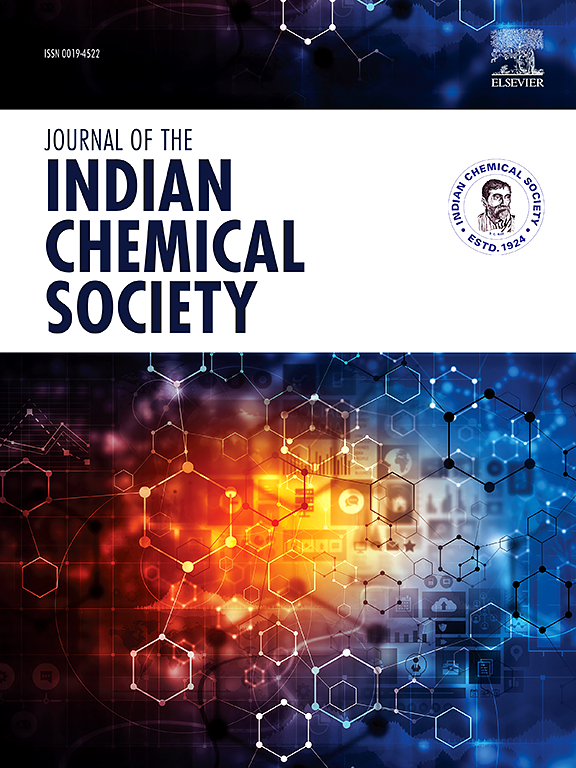Expected coordination and unexpected transformation of the bis(diphenylphosphino)methane in the platinum(II) complex
IF 3.2
4区 化学
Q2 CHEMISTRY, MULTIDISCIPLINARY
引用次数: 0
Abstract
The reaction of a Platinum(II)-DMSO complex with bis(diphenylphosphino)methane (dppm) yielded two distinct complexes. The major product was identified as [PtCl2(dppm)], demonstrating the expected coordination of the intact dppm ligand. However, the minor product exhibited an unexpected transformation, characterized by the cleavage of the dppm carbon bridge, resulting in a phosphorus atom bonded to two phenyl groups and a hydrogen atom. Both complexes were thoroughly investigated using single-crystal X-ray diffraction (SCXRD) and computational methods to determine their quantum parameters. SCXRD analysis revealed that both structures are mononuclear Pt complexes in which the phosphorus atoms of the ligands and the chloride ligands coordinate to the platinum center, adopting a highly distorted tetrahedral geometry. The minor product's structure displayed disorder, with a portion containing an HCl molecule, which was absent in the major product's structure. An analysis of intermolecular interactions revealed various hydrogen-bonding interactions, with chloride atoms acting as hydrogen-bond acceptors. Molecular interactions were further examined using Hirshfeld surface analysis. Density Functional Theory (DFT) calculations were performed using the Def2-SVPD basis set and the B3LYP hybrid functional to investigate the complexes' electronic properties. The computational results showed good agreement with the experimental findings. Furthermore, the energies and distributions of the highest occupied molecular orbital (HOMO) and lowest unoccupied molecular orbital (LUMO) were determined. Finally, molecular docking studies were conducted with Ampicillin-CTX-M-15, which demonstrated a favorable binding interaction between the ligand and targeted amino acid residues, with a binding score of −5.26 kcal/mol.

铂(II)配合物中二(二苯基膦)甲烷的预期配位和意外转化
铂(II)-二甲基亚砜配合物与二(二苯基膦)甲烷(dppm)反应生成两种不同的配合物。主要产物被鉴定为[PtCl2(dppm)],证明了完整的dppm配体的预期配位。然而,次要产物表现出意想不到的转变,其特征是dppm碳桥的裂解,导致磷原子与两个苯基和一个氢原子键合。利用单晶x射线衍射(SCXRD)和计算方法对这两种配合物进行了彻底的研究,以确定它们的量子参数。SCXRD分析表明,这两种结构均为单核铂配合物,配体和氯配体的磷原子均以高度畸变的四面体几何形式与铂中心配位。次要产物结构紊乱,部分含有HCl分子,而在主要产物结构中不存在HCl分子。分子间相互作用的分析揭示了各种氢键相互作用,氯原子作为氢键受体。分子间的相互作用用赫希菲尔德表面分析进一步研究。利用Def2-SVPD基集和B3LYP杂化泛函进行密度泛函理论(DFT)计算,研究配合物的电子性质。计算结果与实验结果吻合较好。此外,还确定了最高已占据分子轨道(HOMO)和最低未占据分子轨道(LUMO)的能量和分布。最后,与Ampicillin-CTX-M-15进行分子对接研究,结果表明该配体与目标氨基酸残基具有良好的结合相互作用,结合评分为−5.26 kcal/mol。
本文章由计算机程序翻译,如有差异,请以英文原文为准。
求助全文
约1分钟内获得全文
求助全文
来源期刊
CiteScore
3.50
自引率
7.70%
发文量
492
审稿时长
3-8 weeks
期刊介绍:
The Journal of the Indian Chemical Society publishes original, fundamental, theorical, experimental research work of highest quality in all areas of chemistry, biochemistry, medicinal chemistry, electrochemistry, agrochemistry, chemical engineering and technology, food chemistry, environmental chemistry, etc.

 求助内容:
求助内容: 应助结果提醒方式:
应助结果提醒方式:


